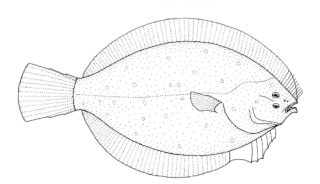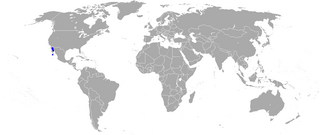
Flounders are a group of flatfish species. They are demersal fish, found at the bottom of oceans around the world; some species will also enter estuaries.

A flatfish is a member of the ray-finned demersal fish order Pleuronectiformes, also called the Heterosomata, sometimes classified as a suborder of Perciformes. In many species, both eyes lie on one side of the head, one or the other migrating through or around the head during development. Some species face their left sides upward, some face their right sides upward, and others face either side upward.

Pleuronectidae, also known as righteye flounders, are a family of flounders. They are called "righteye flounders" because most species lie on the sea bottom on their left sides, with both eyes on their right sides. The Paralichthyidae are the opposite, with their eyes on the left side. A small number of species in Pleuronectidae can also have their eyes on the left side, notably the members of the genus Platichthys.

The black flounder is a flatfish of the genus Rhombosolea, found around New Zealand in shallow enclosed waters and coastal freshwater lakes. Its adult length ranges from 20 to 45 cm.

Large-tooth flounders or sand flounders are a family, Paralichthyidae, of flounders. The family contains 14 genera with a total of about 110 species. They lie on the sea bed on their right side; both eyes are always on the left side of the head, while the Pleuronectidae usually have their eyes on the right side of the head.

The yellowbelly flounder is a flatfish of the genus Rhombosolea, found around New Zealand. A different species from the genus Rhombosolea is found in Australia and also goes by the name yellow-belly flounder. The Māori people have commonly fished for R.leporina, and many other species of flatfish, throughout New Zealand's coastal waters for hundreds of years. The Māori name for this species is 'patiki totara'.

The New Zealand turbot, Colistium nudipinnis, is a righteye flounder of the subfamily Rhombosoleinae in the family Pleuronectidae, found around New Zealand in shallow enclosed waters.

Rhombosolea is a genus of righteye flounders. The four species in this genus can be found in the waters around New Zealand and southern Australia.

The European flounder is a flatfish of European coastal waters from the White Sea in the north to the Mediterranean and the Black Sea in the south. It has been introduced into the United States and Canada accidentally through transport in ballast water. It is caught and used for human consumption.

The Samaridae are a family, the crested flounders, of small flatfishes native to the Indo-Pacific. They were formerly classified as a subfamily of Pleuronectidae. The family contains four genera with a total of almost 30 species.

Clidoderma is a genus of righteye flounders containing one extant species and two described fossil species from Japan.

Platichthys is a genus of flatfish native to the North Pacific and North Atlantic oceans. Despite being in the family Pleuronectidae, all three species in the genus Platichthys are often "lefteyed", i.e. they lie on the sea bottom on their right side, with both eyes on the left side.

The Pacific sand sole, also known as simply sand sole, is a flatfish species inhabiting the northeastern Pacific waters where it lives on sandy bottoms. The only species in the genus, Psettichthys, it ranges from the Bering Sea to Northern California.

The Remo flounder, Oncopterus darwinii, is an edible flatfish of the family Pleuronectidae. It is a demersal fish that lives on bottoms at depths of between 20 and 80 metres. Its native habitat is the southwestern Atlantic along the southeast coast of South America, from Santa Catarina, Brazil in the north to the San Matías Gulf, Argentina in the south. It can reach 30 centimetres (12 in) in length.

The Indonesian ocellated flounder, Psammodiscus ocellatus, is an edible flatfish of the family Pleuronectidae. It is a demersal fish that lives on sandy bottoms in the eastern Indian Ocean, particularly Indonesia and northwestern Australia. It can reach 15 centimetres (5.9 in) in length.

The Poecilopsettidae are a family of flatfish in the order Pleuronectiformes, comprising three genera and 21 species. Species are typically demersal, living on marine bottoms at depths between 60 and 500 m in the Indo-Pacific and northwestern Atlantic; the deepest recorded occurrence is 1,636 m (5,367 ft) in the deepwater dab, Poecilopsetta beanii. Sizes range from 9 to 19 cm in length, though most species are usually under 15 cm (5.9 in) long. Diets consist of zoobenthos.
The peppered flounder is a flatfish of the family Paralichthodidae and the only species of the genus Paralichthodes. It is a demersal fish that lives on sandy and muddy bottoms in subtropical waters, at depths of up to 100 metres (330 ft). Its native habitat is the southeastern Atlantic and the western Indian Ocean, specifically the African coastline from Mossel Bay, South Africa, to Delagoa Bay, Mozambique. It grows up to 50 centimetres (20 in) in length.

The ocellated turbot is a flatfish of the family Pleuronectidae. It is a demersal fish that lives on bottoms at depths of between 1 and 140 metres. Its native habitat is the subtropical waters of the Eastern Pacific, specifically southern Baja California and the upper Gulf of California ; it is the only member of the genus to prefer subtropical waters. It can grow up to 24 centimetres (9.4 in) in length.

The small-mouth righteye flounder is a flatfish of the family Pleuronectidae. It is a demersal fish that lives on saltwater bottoms from depths of 304 metres (997 ft). Its natural habitat is the tropical waters of the southwest Pacific. It can grow up to 10 centimetres (3.9 in) in length.

The eyed flounder is a species of fish in the family Bothidae. The species is found on or near the sandy seabed in relatively shallow waters in the western Atlantic Ocean, the Caribbean Sea and the Gulf of Mexico.



















